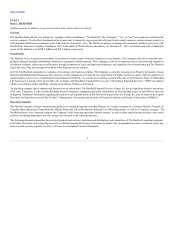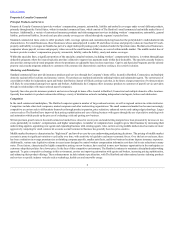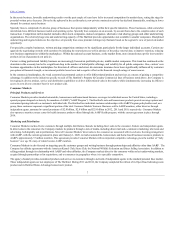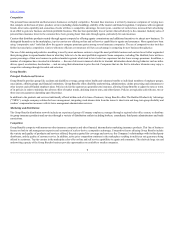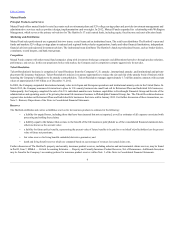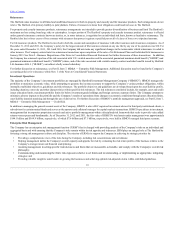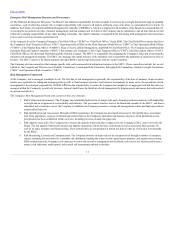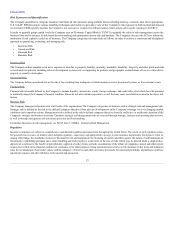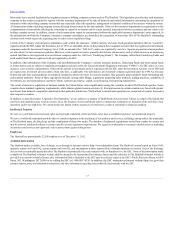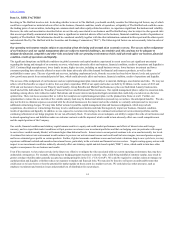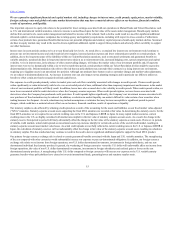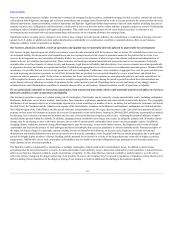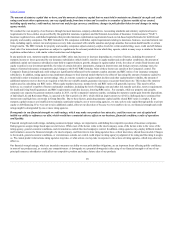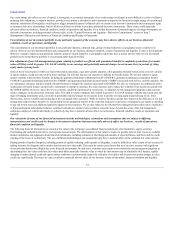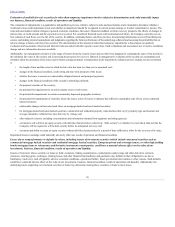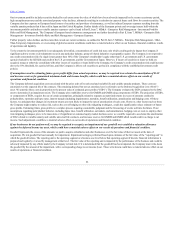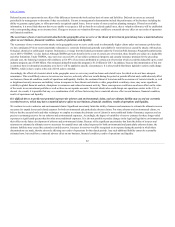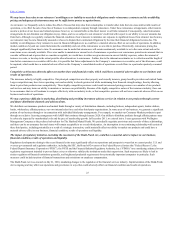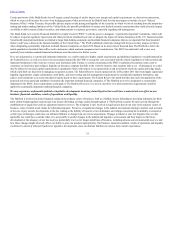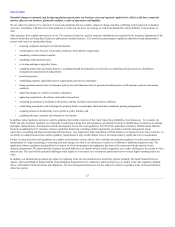The Hartford 2012 Annual Report Download - page 15
Download and view the complete annual report
Please find page 15 of the 2012 The Hartford annual report below. You can navigate through the pages in the report by either clicking on the pages listed below, or by using the keyword search tool below to find specific information within the annual report.
Table of Contents
We are exposed to significant financial and capital markets risk, including changes in interest rates, credit spreads, equity prices, market volatility,
foreign exchange rates and global real estate market deterioration that may have a material adverse effect on our business, financial condition,
results of operations, and liquidity.
One important exposure to equity risk relates to the potential for lower earnings associated with our operations in Mutual Funds and Talcott Resolution, such
as U.S. and international variable annuities, where fee income is earned based upon the fair value of the assets under management. Should equity markets
decline from current levels, assets under management and related fee income will be reduced. Such a decline could result in a need for significant additional
allocated capital to certain insurance companies due to rating agency and regulatory requirements, including with respect to stress scenarios. Furthermore,
certain of our products have guaranteed benefits that increase our potential obligation and statutory capital exposure should equity markets decline. Sustained
declines in equity markets may result in the need to devote significant additional capital to support these products and adversely affect our ability to support
our other businesses.
Interest rates in recent periods continue to be at or near historically low levels. As noted above, a sustained low interest rate environment would continue to
pressure our net investment income and could result in lower margins, increased pension expense and lower estimated gross profits on certain products. In
addition, due to the long-term nature of the liabilities within our Talcott Resolution operations, such as structured settlements and guaranteed benefits on
variable annuities, sustained declines in long-term interest rates subjects us to reinvestment risks, increased hedging costs, spread compression and capital
volatility. A rise in interest rates, in the absence of other countervailing changes, will reduce the market value of our investment portfolio and, if long-term
interest rates were to rise dramatically within a six-to-twelve month time period, certain products within our Talcott Resolution division might be exposed to
disintermediation risk. Disintermediation risk refers to the risk that our policyholders may surrender their contracts in a rising interest rate environment,
requiring us to liquidate assets in an unrealized loss position. Although our products have features such as surrender charges and market-value adjustments,
we are subject to disintermediation risk. An increase in interest rates can also impact our tax planning strategies and in particular our ability to utilize tax
benefits to offset certain previously recognized realized capital losses.
Our exposure to credit spreads primarily relates to market price and cash flow variability associated with changes in credit spreads. If issuer credit spreads
widen significantly or retain historically wide levels over an extended period of time, additional other-than-temporary impairments and decreases in the market
value of our investment portfolio will likely result. In addition, losses have also occurred due to the volatility in credit spreads. When credit spreads widen, we
incur losses associated with the credit derivatives where the Company assumes exposure. When credit spreads tighten, we incur losses associated with
derivatives where the Company has purchased credit protection. If credit spreads tighten significantly, the Company's net investment income associated with
new purchases of fixed maturities may be reduced. In addition, a reduction in market liquidity can make it difficult to value certain of our securities when
trading becomes less frequent. As such, valuations may include assumptions or estimates that may be more susceptible to significant period-to-period
changes, which could have a material adverse effect on our business, financial condition, results of operations or liquidity.
Our statutory surplus is also affected by widening credit spreads as a result of the accounting for the assets and liabilities on our fixed market value adjusted
(“MVA”) annuities. Statutory separate account assets supporting the fixed MVA annuities are recorded at fair value. In determining the statutory reserve for the
fixed MVA annuities we are required to use current crediting rates in the U.S. and Japanese LIBOR in Japan. In many capital market scenarios, current
crediting rates in the U.S. are highly correlated with market rates implicit in the fair value of statutory separate account assets. As a result, the change in the
statutory reserve from period to period will likely substantially offset the change in the fair value of the statutory separate account assets. However, in periods
of volatile credit markets, actual credit spreads on investment assets may increase sharply for certain sub-sectors of the overall credit market, resulting in
statutory separate account asset market value losses. As actual credit spreads are not fully reflected in current crediting rates in the U.S. or Japanese LIBOR in
Japan, the calculation of statutory reserves will not substantially offset the change in fair value of the statutory separate account assets resulting in reductions
in statutory surplus. This has resulted and may continue to result in the need to devote significant additional capital to support the fixed MVA product.
Our primary foreign currency exchange risk is related to certain guaranteed benefits associated with the Japan and U.K. variable annuities. The strengthening
of the yen compared with other currencies would substantially increase our exposure to pay yen-denominated obligations. In addition, our foreign currency
exchange risk relates to net income from foreign operations, non-U.S. dollar denominated investments, investments in foreign subsidiaries, and our yen-
denominated individual fixed annuity product. In general, the weakening of foreign currencies versus the U.S. dollar will unfavorably affect net income from
foreign operations, the value of non-U.S. dollar denominated investments, investments in foreign subsidiaries and realized gains or losses on the yen
denominated annuity products. A strengthening of the U.S. dollar compared to foreign currencies will increase our exposure to the U.S. variable annuity
guarantee benefits where policyholders have elected to invest in international funds, generating losses and statutory surplus strain.
15


